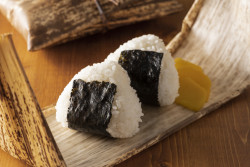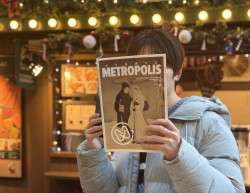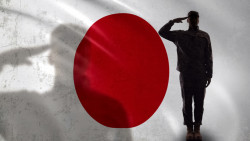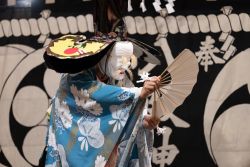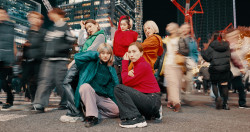
Originally published on metropolis.co.jp on April 2011

Hana greets Masaaki Tanemura. By Dreux Richard

Abe and Lyubykh cross the Tatar Strait. By Isami Abe

Isami Abe (second from left) hosts a post-race dinner at his workshop. By Dreux Richard

Mamiko Kasai shares pictures of her dogs. By Dreux Richard

Karafuto Ken in Akita Prefecture following post-war repatriation. Courtesy Isami Abe

Abe travels to Sakhalin. Courtesy Isame Abe

Katsuhiko Momma at Showa Research Station in 1979. Courtesy Isami Abe
When Hachiko got the Disney treatment in 2009, the dog enjoyed title billing. Canine brothers Taro and Jiro, on the other hand, would probably fire their agent if they were alive to do it. In 1958, 15 sled dogs were left tied up outside Japan’s Showa Antarctic Research Station following an unplanned evacuation. Eight dogs slipped their collars, and only two survived until personnel returned a year later—Taro and Jiro, who have been household names in Japan ever since. Hollywood glibly re-imagined their ordeal in 2006’s Eight Below. Their names don’t appear in the script, and Siberian Huskies were cast in place of their little-known, rapidly disappearing breed: the Karafuto Ken.
Nankyoku Monogatari, a 1983 blockbuster that hewed closer to the facts, featured mixed-breed look-alikes. The movie sparked a Karafuto Ken renaissance and gave rise to a remarkable dogsledding community in Japan. But fame hasn’t saved the breed, which most Japanese mistake for Akita or Siberian Huskies. Karafuto Ken have moved swiftly toward extinction, and Japanese dogsledding is headed in the same direction.
This upsets legendary musher Isami Abe, whose championship teams have included Taro’s progeny. His dog, Hana, 12 years old and in poor health, is one of Japan’s two remaining purebred Karafuto Ken (her brother Kuma is the other). Abe’s work on the breed’s behalf has involved the importation of breeding stock from Russia and a historical crossing of the Tatar Strait by dogsled. Eight years retired from mushing, Abe has sworn off media interviews and dogsled races. When I met him, it was going on six years since he’d bothered with either.
But in February he showed me around Wakkanai, Japan’s northernmost city and his lifelong home. Day two included his first appearance at a dogsled race since 2006. Why? Because a shift has occurred since he last spoke to a journalist. What was once a warning is now a declaration.
“The Karafuto Ken is effectively extinct,” Abe says. “And no one has even noticed.”
Abe doesn’t attend the first day of the 2011 Japan Cup National Dogsled Races, but he does host a dinner at his workshop afterward. This is where I meet him, Hana and his other guests, including Masaaki Tanemura, another retired musher of note.
Over dinner, Abe and Tanemura trace the breed’s decline, which was sparked by the forced repatriation of Japanese and Ainu people to mainland Japan from Sakhalin Island (former Karafuto) after World War II, and aggravated by post-war industrialization. In short, the Karafuto Ken—an Ainu working dog well-suited to snowbound, rural areas—has lost its stewards, its habitat, and its economic relevance. Repatriation also decentralized the breed’s postwar population (roughly 1,000 in 1945), leaving local gene pools shallow and leading to interbreeding.
As for the breed’s brief renaissance following the release of Nankyoku Monogatari, I’m speaking with its principal figures. Abe and Tanemura are founding members of the Antarctica Dogs Association, a group that was entrusted with seven of the film’s canine actors after production wrapped. The organization has since fought to preserve the Karafuto Ken.
It’s a battle they now admit they never could have won. The culture that the breed inhabited has slipped past the vanishing point.
“When I was a kid, my mother used our Karafuto Ken to pull her vegetable cart into the city,” Abe says. In contrast, Hana spends most of her time caged in his garage.
After dinner, Abe plays an old VHS copy of Karafuto Ken ni Yume Hasete, a TV documentary about the trips he took to Sakhalin 12 years ago to retrieve five purebred puppies, Hana and Kuma among them, and later to cross the Tatar Strait.
The documentary begins with a meeting of the Antarctica Dogs Association, which gathered around the same table we’ve been eating off of here in Abe’s workshop. At the end of the scene, the camera frames Tanemura. “If we forget about this dog,” he says, “We forget about Japan’s way of life before the war.”
The room is quiet while the scene plays. Abe and Tanemura watch their younger selves, and the other dinner guests look from the television to their faces, searching for a flicker of loss. The second day of the Japan Cup seems well-attended, but Abe, who was vice president of the race’s organizing committee for nine years, puts this in perspective.
“Fifteen years ago, around the time of the 13th Japan Cup, there were 1,400 trained sled dogs in Hokkaido alone,” he says. “And there were dogsled events in most prefectures.” By comparison, today’s Hokkaido boasts 200 sled dogs, and activity further south is minimal.
It’s tempting to imagine that Japanese dogsled racing was a fad that waned as Nankyoku Monogatari faded from public consciousness. But training sled dogs requires a sustained effort that transcends fandom, and the sport nonetheless expanded for 15 years after the film’s release. Its decline, instead, is a generational issue. Old die-hards have retired, and the group of enthusiasts replacing them is smaller and less committed.
“Young people don’t need dogsleds,” Abe says. “They’ve got snowmobiles.”
Because dogsled racing in Japan has never been a vehicle for fame, Abe’s presence at the race goes largely unnoticed. The day’s most moving moment arrives with Mamiko Kasai, an amateur dog breeder and Karafuto Ken preservationist from Asahikawa, who, shocked that Abe has shown up, approaches him tearfully and shares pictures of her dogs. They’re at best one-quarter Karafuto Ken.
Despite it all, Abe enjoys himself. It’s good to see old friends, and his love of dogsledding is unconditional. But the day ends on a low note when a snow squall kicks up and the juniors’ races are canceled.
“That was the worst thing that could have happened,” he says. “The older guys, they’ve had their races. But the kids waited all year for this, and who knows how many more chances they’ll get?”
The day before I leave Wakkanai, Katsuhiko Momma, radio technician for Japan’s 1979 mission to Antarctica and a close friend of Abe’s, escorts me to a musty hangar in the city science museum’s backyard. The left-hand wall of the hangar is covered in a photojournalistic history of the Karafuto Ken’s involvement in Antarctic exploring. Newspaper articles about Taro and Jiro are arranged in careful chronology, punctuated by framed prints of archival photographs. But the hangar’s pièces de résistance are two modular buildings from the first iteration of Japan’s Showa Research Station—the very buildings Taro and Jiro were tied outside of and left for dead.
Momma, who spent fifteen months at Showa, makes his way through them gradually, pausing often for contemplation. I share his sense of the sacred here. The hangar is a mausoleum for modern folklore.
“This is open to the public,” he says. “But I can’t remember the last time anyone came to see it.”
Abe’s trips to Sakhalin between 1998 and 2000 yielded his greatest personal triumphs, but they also forced him to confront the impossibility of the Karafuto Ken’s survival. On his first trip, he retrieved five puppies from Sergei Lyubykh, who breeds Karafuto Ken on his farm in northern Sakhalin’s Nekrasovka Village. The importation of Lyubykh’s puppies revealed major bureaucratic hurdles and deep institutional indifference to the breed’s preservation. No dogs have been imported since, and Lyubykh, the only other documented owner of purebred Karafuto Ken, has told Abe that the few he still owns are too closely related to continue breeding effectively.
Abe considers his subsequent crossing of the Tatar Strait with Lyubykh a sterling act of unprecedented cooperation between a Russian musher and his Japanese counterpart. But the trip also offered glimpses across a shifting cultural landscape. Lyubykh’s dogs had been trained to detect and avoid cracks in the pack ice, leading to constant complaints from the Karafuto Ken ni Yume Hasete film crew that the crossing was going too smoothly and would make for bad television. The team also stopped for a night to share dinner with an Ainu family. The father and mother over-imbibed, and while mom, who didn’t speak Japanese, performed Japanese pop songs she’d learned from their generator-powered shortwave radio, dad arranged to trade the family’s Karafuto Ken to Lyubykh for more booze.
In short, ours is not the world from whence the Karafuto Ken came. Sakhalin is no exception. Neither is Wakkanai, which has sprawled and suburbanized. Hana will spend the remainder of her life chained to the inside of her cage lest she meet her maker at the business end of a Honda, like her niece did years ago.
The Karafuto Ken may be a relic, but considering the changes in human lives the breed has witnessed, we might share one defining experience with it: the ongoing, rapid and unnoticed loss of everything familiar.
This article is indebted to the translation work of Steve Sasaki. Contact the author: soireadyourstory@gmail.com
Taro and Jiro’s Tokyo

Dreux Richard
- Kokuritsu Kagaku Hakubutsukan The National Science Museum near Ueno Park’s main entrance where stuffed Jiro shares a glass case with Hachiko. Head to the 2nd floor where you’ll find him in ‘Japanese People and Nature.’
- Tokyo Tower Go for the view, but stay for the statues. The Japanese SPCA put thirteen of them up at the entrance to the tower in memory of the dogs that didn’t make it.
- Animal Refuge Kansai Do Taro and Jiro a cosmic solid by paying a visit to ARK’s Tokyo office. You can adopt dogs, volunteer to cuddle or walk them, donate money or even pitch in a few key items the organization lists on its website, www.arkbark.net.
Pop Culture Pawprints
- Nankyoku Monogatari This 1983 Japanese blockbuster starring Karafuto Ken look-alikes features immortal tough guy Ken Takakura, a soundtrack by Vangelis (of Pure Moods fame), and a fight between a pack of sled dogs and a seal the size of an RV.
- Karafuto Ken ni Yume Hasete TV documentary that follows Abe on his trips to Sakhalin. Features his quintessentially Russian counterpart, Sergei Lyubykh, whose memorable quotes include: “I bury my puppies in the snow to see if they’ll fight to live.” Request a copy via www.asahi-tv.co.jp/telementary.
- Karafuto Inu Monogatari Huge, hardbound, immaculately illustrated 1982 book by Yasuichi Kitamura, who trained the Antarctic sled dogs. Charmingly dated and definitively Japanese, featuring careful profiles of the 1958 expedition’s canine members, the book can be had for pocket change on Amazon Japan.


